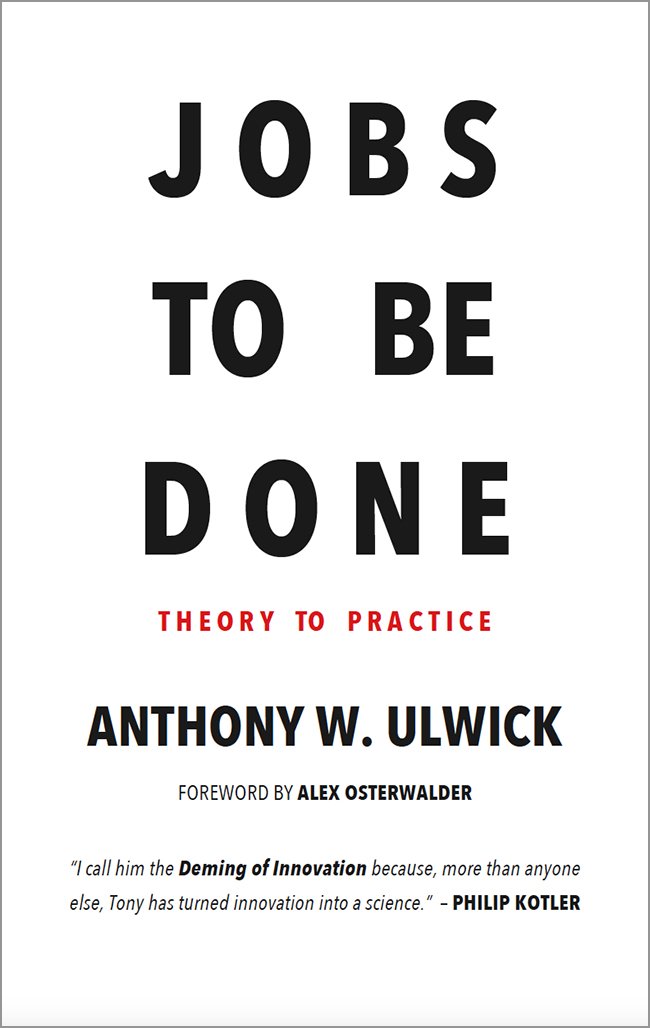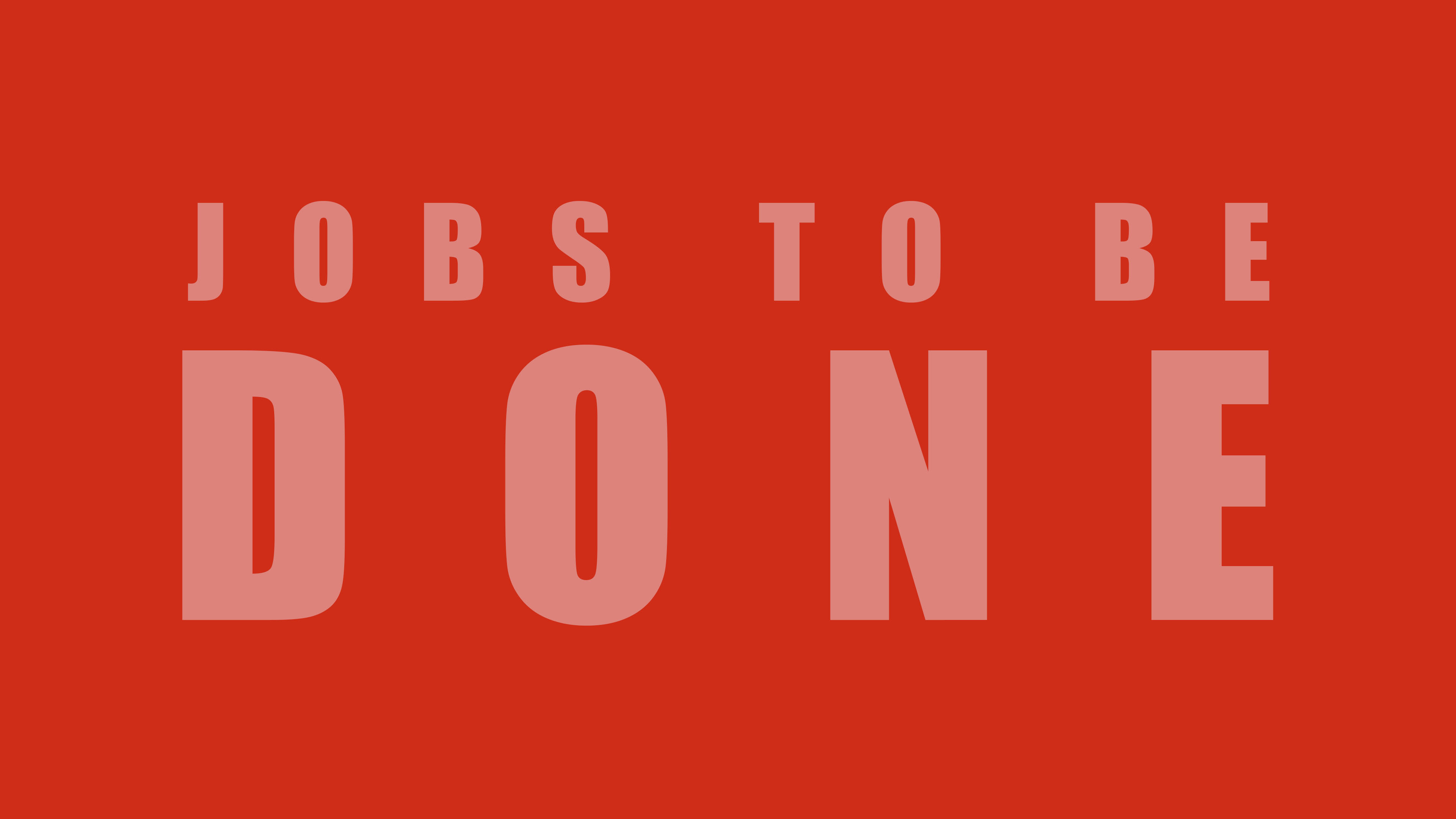
JOBS TO BE DONE: A SUMMARY
Introduction
Successful innovation and improved business outcomes can be achieved by applying objectivity, targeted strategy, and the Jobs-to-be-Done mindset. Guesswork and lucky ideas are not reliable approaches to innovation.
Chapter 1
Why do Innovation Projects Fail?
Innovation can be approached in two ways: “Ideas-First” or “Needs-First.” The “Ideas-First” approach involves generating ideas and testing them to see if they meet customer needs. However, this approach has flaws. Firstly, it is unlikely to uncover all customer needs. Secondly, without knowing the needs, it is challenging to filter and evaluate ideas effectively. Lastly, customers cannot always articulate the solutions they want, so relying solely on their input may not lead to successful innovations.
On the other hand, the “Needs-First” approach is preferable, but it also has limitations. One common challenge is the lack of a shared language to communicate customer needs effectively. Before achieving successful innovation, managers must agree on what constitutes a need and understand the different types of needs customers have.
To improve innovation practices, it is important to adhere to certain principles.
- Firstly, avoid relying solely on the flawed “Ideas-First” approach. Instead, prioritize the “Needs-First” approach.
- Secondly, recognize that innovation should be treated as a scientific process rather than an artistic endeavor.
- Thirdly, challenge the assumption that capturing a complete set of customer needs is impossible.
- Lastly, establish a clear definition of what a need is and develop effective methods for capturing and communicating those needs.
Chapter 2
Jobs-To-Be-Done Needs Framework
To create compelling and innovative products for customers, it is crucial to understand their needs and identify any unfulfilled or unrecognized ones. The key is to provide products that help customers make progress towards meeting those needs.
People don’t want to buy a quarter-inch drill. They want a quarter-inch hole!
- Theodore Levitt Tweet
Once needs are gathered and categorized, it is important to pinpoint the underserved or unmet needs. This can be achieved by utilizing tools such as the Importance/Satisfaction matrix. Companies aim to uncover the functional jobs that customers are trying to accomplish for two main reasons: to discover new opportunities or markets to target and to redefine their existing market in order to better serve it using the Jobs-to-be-Done Theory.
In the Jobs-to-be-Done (JTBD) Framework, a functional job possesses three key characteristics:
- Remains stable over time,
- Has no geographical limitations
- Independent of specific solutions
Here is an example JTBD Statement
[Verb] [Object of verb] [Contextual modifier] [Object of the verb]
[Chill] [my perishable food] [at home] [for example, for groceries I purchased for later consumption]
Job Map
To effectively identify and capture needs, the job map is utilized, which helps generate measurable, controllable, actionable, solution-free, and stable desired-outcome statements. Here is a job map:
Define->Locate->Prepare->Confirm->Execute->Mointor->Modify->Conclude
Desired Outcome Statement
Based on the job map, further research is necessary to identify and capture needs in terms of desired-outcome statements. Various types of customer jobs exist, including the core functional job (the desired task or outcome), related jobs (additional needs customers have while accomplishing the core job), emotional and social jobs (how customers want to feel or avoid feeling), consumption chain jobs (supporting the product lifecycle), and financial outcomes (metrics guiding product decisions).
[Direction of improvement] [Unit of measure] [Object of control] [Contextual clarifier] [Example of object of control]
[Reduce] [time] [to style my hair] [while getting ready in the morning] [for example drying my hair after a shower]
Most companies are great at creating products—they just aren’t that great at creating the right products.
- Anthony W. Ulwick Tweet
Chapter 3
The Jobs-to-be-Done Growth Strategy Matrix
Once we have a clear understanding of our customers and their needs, the next step is to identify which of those needs are either underserved or overserved. This knowledge will guide our strategy going forward.
When evaluating our product in comparison to competitors based on price and performance, it’s not sufficient to be slightly better or cheaper. Such marginal improvements won’t differentiate our product enough to justify customers switching from existing options in the market.
There are five strategies to address a given situation:
- Differentiated Strategy – Target underserved customers with an offering that outperforms existing options.
- Dominant Strategy – Target all customers with an offering that is significantly better and cheaper.
- Disruptive Strategy – Target new or overserved customers with an offering that provides a more affordable solution.
- Discrete Strategy – Target customers with unique restrictions by capitalizing on the scarcity of access to a product.
- Sustaining Strategy – Target existing customers by making incremental improvements in the offering or price.
It’s important to note that a company may have multiple products and services in a single market, each employing different strategies. Therefore, it’s crucial to examine examples at the product level rather than the company level.
To determine whether there are underserved or overserved needs in our target customers and segment, we should use prioritized outcome statements.
A differentiating strategy is effective when entering a new market by initially targeting high-end customers, capturing a share, and then gradually expanding to gain additional market share.
For a dominant strategy to succeed, our offering must be at least 20% better and 20% cheaper than the alternatives in the market.
A disruptive strategy works well in situations where customers are overserved, as it allows them to achieve the same result at a lower cost. It can also attract non-customers by reducing the financial barrier to entry.
A discrete strategy is suitable when a unique situation or restriction justifies a higher price for a product.
A sustaining strategy helps an incumbent company maintain its market position through small incremental improvements, but it should be avoided for new products.
Chapter 4
Outcome Driven-Innovation
Understanding the Jobs-to-be-Done theory is not enough; we need a specific, clear, and repeatable practice to put it into action. Outcome-Driven Innovation (ODI) is the process that allows us to apply the Jobs-to-be-Done theory effectively.
ODI Process
The Outcome-Driven Innovation process consists of ten steps:
- Define the customer.
- Define the Jobs-to-be-Done.
- Uncover customer needs.
- Find segments of opportunity.
- Define the value proposition.
- Conduct a competitive analysis.
- Formulate the innovation strategy.
- Target hidden growth opportunities.
- Formulate the market strategy.
- Formulate the product strategy.
When identifying customers, it is important to consider three types:
- the end user
- the product life cycle support team
- the purchase decision maker
However, our goal should be to simplify or eliminate the need for the product life cycle support team whenever possible.
Defining the job too narrowly will limit the discovery of growth opportunities, while defining it too broadly will result in non-actionable insights. It’s crucial to look beyond our product and understand how it fits within the broader value chain of all the steps required to accomplish the job.
Job Statement
A well-crafted job statement should be written from the customer’s perspective, one-dimensional and mutually exclusive, devoid of emotive statements, focused on defining the need rather than the situation, and follow the job-statement format (verb + noun + context).
Once the job is identified, a job map should be created to model all the steps or processes involved in completing the job. This map represents the ideal process flow applicable to all customer situations regardless of the products they are using.
8 Process Steps
Most jobs can be broken down into eight fundamental process steps:
- define
- locate
- prepare
- confirm
- execute
- monitor
- modify
- conclude
Outcome Statement
Outcome statement = direction of improvement + performance metric + object of control + contextual clarifier
An outcome statement should include the direction of improvement, performance metric, object of control, and contextual clarifier.
Desired outcome statements can be captured through qualitative data gathering techniques such as interviews, surveys, focus groups, and observations.
Instead of segmenting based on a specific market or customer archetype, focus on common needs and outcomes for outcome-based segmentation.
To develop a winning value proposition, we must target and satisfy the underserved needs of the customer, communicate how their needs can be fulfilled, and outperform competitors in meeting those needs.
When conducting a competitive analysis, it’s important to assess offerings quantitatively against desired outcome statements rather than comparing feature sets.
Opportunity Scoping
Opportunity Score is a metric used to objectively identify underserved outcomes, calculated as the sum of outcome importance and the difference between outcome importance and satisfaction.
Qualitative methods help uncover the customer’s Jobs-to-be-Done and desired outcome, while quantitative research helps identify outcome-based segments and assess their current satisfaction.
6 Step Marketing Strategy
The six steps for developing an effective market strategy include:
- targeting specific offerings at each outcome-based segment
- communicating strengths to the target segment
- incorporating an outcome-based value proposition
- building a digital marketing strategy around unmet outcomes
- assigning leads based on segments
- equipping the sales team with effective tools
Before defining the product strategy, prioritize underserved outcome statements to establish the initial backlog.
7 Approaches to Product Strategy
- borrowing features from other offerings
- accelerating pipeline and R&D efforts
- partnering or licensing from other firms
- acquiring companies to fill gaps
- devising new feature sets
- creating new subsystems or ancillary services
- conceptualizing the ultimate solution
Chapter 5
Case Studies
Microsoft
Microsoft faced a crisis as its Software Assurance offering was not meeting customer needs and renewal rates were declining. By adopting an Outcome-Driven Innovation (ODI) approach, Microsoft identified the jobs and desired outcomes of procurement managers and IT professionals. They discovered underserved segments and developed a new perspective on the customer lifecycle. Microsoft found that they already had solutions to address customer needs and packaged them into a comprehensive offering. This led to increased revenue, customer satisfaction, and salespeople feeling empowered.
Kroll Ontrack
Kroll Ontrack recognized the emerging market for electronic document discovery in the legal industry but struggled to develop an effective strategy. They turned to ODI to understand what lawyers wanted to achieve. Through interviews and analysis, they identified desired outcomes related to document discovery. This guided the development of innovative solutions such as Harvester and custom-coding features. By focusing on customer outcomes, Kroll Ontrack surpassed competitors and experienced significant revenue growth, becoming an industry leader.
Arm & Hammer Animal Nutrition
Arm & Hammer Animal Nutrition sought to improve their innovation efforts after disappointing product launches. They adopted ODI to understand customer needs in the dairy market. Previously, they relied on discussions with nutritionists but realized they needed insights from the dairy producers themselves. ODI helped them identify the right customers to engage with and gain valuable insights. This shift led to over 30% revenue growth and surpassed competitors in the animal nutrition industry.
Bosch Case Study
Bosch, a tool company, faced challenges when entering the North American circular saw market. They aimed to compete with established brands, gain shelf space in big-box retailers, and price their product competitively. To uncover market opportunities, they targeted professional tradesmen and analyzed their needs through interviews and surveys. They discovered an underserved segment of users who required specific features for finish and advanced carpentry work. By addressing their unmet needs, Bosch developed a highly innovative circular saw that satisfied customers and increased satisfaction levels by 38%. They successfully launched the product, gained support from major distributors, and received recognition for their innovation.
Abbott Medical Optics Case Study
Abbott Medical Optics (AMO) wanted to improve its service offerings and attract customers by providing secondary services. They targeted materials managers in medical facilities responsible for replenishing ophthalmic lenses for surgeries. Through interviews and surveys, they identified underserved outcomes and discovered flaws in their service delivery approach. AMO transitioned to a relationship-based customer service approach, assigning dedicated advocates and regional customer care teams to address customer issues. They also developed advanced software for inventory management. These innovations resulted in improved customer satisfaction, increased Net Promoter scores, and positive industry perceptions.
Hussmann Case Study
Hussmann aimed to boost the adoption of its LED product line for refrigeration cases. Despite energy efficiency benefits, customers were skeptical. To uncover customer needs, they used the ODI methodology and engaged shoppers, store merchandisers, and executive merchandisers. By analyzing their responses and prioritizing desired outcomes, they identified unmet needs related to display case lighting. Hussmann then developed a new portfolio of LED lights that addressed these needs, such as uniform lighting and accurate product color display. This customer-focused innovation helped Hussmann differentiate its product and gain market acceptance.
Chapter 6
Becoming an ODI Practitioner
- Initiation: The first phase of an ODI engagement is to clearly define the goal and develop a plan to apply ODI effectively. This involves gaining support for the goal, creating a project plan, mapping out initial tasks through interviews and research, and obtaining endorsement for the proposed plan.
- Uncover Customer Needs: In this phase, the focus is on identifying and capturing the complete set of customer needs in the form of desired-outcome statements. This is done through targeted customer interviews to understand their requirements and capturing their desired outcomes. It also involves uncovering any complementary jobs related to the needs.
- Data Gathering: The goal of the Data phase is to synthesize customer understanding into quantitative insights that can guide market and product strategies. This includes establishing a mechanism to capture and weigh customer insights, analyzing customer segments and competitors, and identifying and quantifying needs that are underserved or overserved.
- Analysis: The Analysis phase aims to synthesize and analyze the qualitative and quantitative data collected to reveal insights that inform future market and product decisions. This involves identifying an appropriate segmentation model, determining under/overserved needs within each segment, assessing the competitive positioning, and identifying commercially viable opportunities in each segment.
- Market Strategy: This phase focuses on developing a strategy to market the product based on the identified outcome-based segments and desired outcomes. It includes deciding which segments and outcomes to target, defining the value proposition and messaging, establishing a marketing plan, and aligning the company with the strategy.
- Product Strategy: The Product Strategy phase aims to develop a strategy for product development aligned with the outcome-based segments and desired outcomes. This involves determining areas to address within the product, facilitating ideation for product improvement, refining the delivery plan, and obtaining the necessary resources for execution.
Chapter 7
Transforming the Organization
Training everyone is unnecessary and wasteful. What businesses truly need is a small, independent group that can think outside the box and create unmatched offers.
Innovation should not be the responsibility of everyone; instead, a select few should be tasked with informing decision-makers about market entry, growth, and product development.
The objective is to assemble a team with the necessary skills to become change catalysts, free from the constraints of existing business paradigms.
While most companies excel at product creation, they often struggle to develop the right products.
Build your outcome-driven organization by following these three steps:
- Understand the jobs your customers want to be done.
- Discover hidden opportunities in your market.
- Utilize new customer insights to drive growth.
Establishing a Job Map and desired-outcome statements provides enduring assets that can guide ongoing innovation efforts.
With these tools, you can gain insights into your products and competitors. You can then leverage these insights to enhance existing products and services or create entirely new ones that address unmet and underserved customer needs.
Conclusion
This is currently one of the most cited books in the entrepreneurial world. I definitely consider it a “must read” and you won’t fully understand the implementation without reading the example applications provided by the author in the book.
You can find more information, planning tools and books by Anthony W. Ulwick by going to his website.

Jobs to be Done: Theory to Practice Paperback – January 1, 2016
Author Bio
Benjamin Arritt

Share:
Follow Us:
Most Popular


10+ PERSONAL CRM OPTIONS REVIEWED

10 OUTSOURCED BDR SALES AGENCIES COMPARED

FRACTIONAL MARKETING: EFFICIENT BUSINESS GROWTH
Subscribe To Our Newsletter
No spam. Curated directories & articles about business, startups and templates.
MENU
Related Posts

How to Build a High-Performing Marketing Stack for CMO Success
Dive into our blog post to learn how chief marketing officers can transform from brand champions to revenue drivers and customer whisperers through a strategic

10+ PERSONAL CRM OPTIONS REVIEWED
Yes, there are “solutions,” but nothing is perfect. Here is the path of what I evaluated, what I liked, what I didn’t and why. I

10 OUTSOURCED BDR SALES AGENCIES COMPARED
I interviewed several of the top performers according to Clutch, but this was not my exclusive source. Here’s why: some smaller companies, without as much

FRACTIONAL MARKETING: EFFICIENT BUSINESS GROWTH
Fractional marketing involves hiring fractional marketers, or part-time marketing professionals. This way businesses can leverage specialized expertise while reducing the costs associated with a full-time
